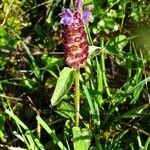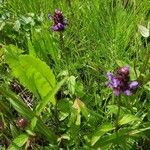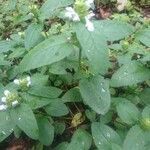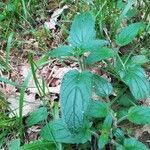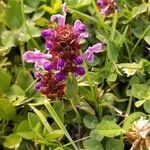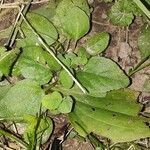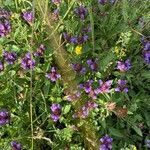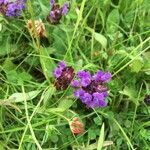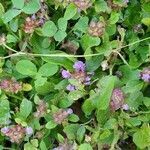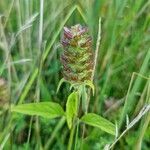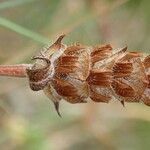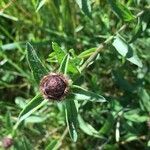Stems 20-30 cm, ascending, base much branched, purple-red, sparsely strigose or subglabrous. Petiole 0.7-2.5 cm, upper ones shorter; leaf blade lanceolate to ovate, 1.5-6 × 0.6-2.5 cm, glabrous to sparsely villous, base truncate to broadly cuneate-decurrent, margin undulate to entire, apex obtuse to rounded. Spikes 2-4 cm, sessile; floral leaves similar to cauline leaves, sessile or short petiolate, subovate; bracts purplish, broadly cordate, ca. 7 × 11 mm, cuspidate, veins sparsely hispid. Calyx campanulate, ca. 1 cm, sparsely hispid, tube ca. 4 mm; upper lip suboblate, subtruncate; lower lip narrower, teeth acuminate. Corolla purplish or white, ca. 1.3 cm, slightly exserted, glabrous; tube ca. 7 mm, base ca. 1.5 mm wide, gradually dilated to ca. 4 mm wide at throat; upper lip subcircular, ca. 5.5 mm in diam., ± galeate, emarginate; lower lip ca. 1/2 as long as upper lip, middle lobe subobcordate, fringed; lateral lobes oblong, spreading, minute. Anterior stamens very long. Nutlets oblong-ovoid, ca. 1.8 × 0.9 mm, slightly 1-furrowed. Fl. Apr-Jun, fr. Jul-Oct.
Perennial, straggling herb, up to 0.3 m high; rooting at nodes, glabrous or sparingly pubescent. Leaves petiolate, ovate to broadly ovate, 20-30 x 12-20 mm, base obtuse, apex rounded, margins entire; sparingly pilose. Inflorescence dense, spike-like or subcapitate, 20-40 mm long; verticils 4-6-flowered; subtended by a pair of leaf-like bracts. Flowers dark blue to purple, rarely white. Calyx tubular-campanulate, subcompressed, 10-nerved, bilabiate; upper lip broad, shortly 3-toothed; lower lip narrower with 2 long, subulate teeth; enlarging slightly at maturity. Corolla: tube shortly exserted from calyx; upper lip erect, somewhat hooded, entire; lower lip slightly shorter, deflexed, 3-lobed. Stamens 4, didynamous, ascending beneath upper lip, lower pair longer. Style bifid, lobes subulate. Fruit an ovoid or oblong nutlet.
Perennial herb. Rhizome short; aerial stems long and decumbent, becoming erect and then often purplish. Petiole often = lamina in lower lvs, becoming short in lvs below infl. Lamina 1.7-6 × 0.7-2.3 cm, ovate or ovate-oblong, hairy, especially on veins below, usually entire or shallowly toothed, or rarely upper lvs with narrow lobes (hybrids); base cuneate to rounded. Bracts 2-10 cm long, broad-ovate to broad-reniform, acuminate, the uppermost often acute, with prominent white cilia and often purple-tinged. Calyx 7-9 mm long, purplish; upper lip shallowly 3-toothed and mucronate; lower lobe of 2 lanceolate, acuminate teeth. Corolla 10-15 mm long, usually violet, rarely pink or white. Stamen appendages ± straight. Nutlets 1.5-2 mm long, ellipsoid or ellipsoid-obovoid, shining brown.
Straggling herb, rooting at the nodes; stems up to 0.3 m long, glabrous or sparingly pubescent. Leaves petiolate; blade ovate to broadly ovate, 20-30 x 12-20 mm, sparingly pilose, apex rounded, base obtuse, margin entire; petiole 10-20 mm long. Inflorescence dense, 20-40 mm long, subtended by a pair of leaf-like bracts; floral bracts ovate-orbicular, about 5 mm long and 6 mm broad, abruptly acute at the apex, often purple-tinged. Calyx 6-7 mm long at flowering, enlarging only slightly at maturity. Corolla dark blue to purple, rarely white, 9-10 mm long; tube about as long as the calyx; upper lip 2.5 mm long, sparingly pubescent, lower lip about 2 mm long.
A creeping herb. It keeps growing from year to year. It has short underground stems or rhizomes which then produce upright stems. It can be slightly hairy. The stems can be 50 cm long. They are square or flattened in cross section and purple in colour. The leaves are oval and can be slightly scalloped. They have leaf stalks. The flowers are deep blue or purple but can be white. They grow in spikes. They are surrounded by rounded bracts with a long tapering point. They are purplish and with white bristles underneath.
